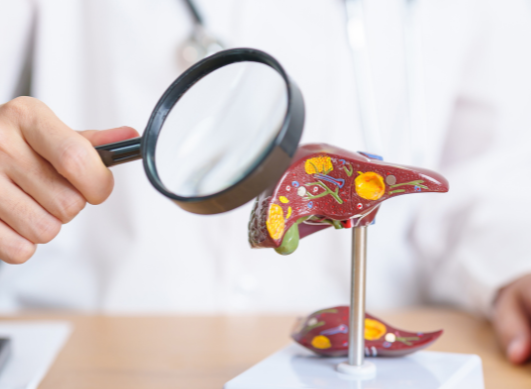Fatty liver and family life: How to find the right balance when living with NAFLD and NASH?
Published 12 Jun 2025 • By Somya Pokharna
Living with a chronic liver condition like NAFLD or NASH often means facing strict dietary changes, chronic fatigue, and ongoing treatment plans that can seem at odds with the everyday joys of sharing meals with family, going out with friends, or simply feeling like yourself. The emotional toll from stigma and social isolation can weigh just as heavily as the physical symptoms.
But does a diagnosis mean giving up on a fulfilling life? How can people with fatty liver disease face and overcome its many psychological and social challenges?
Let’s explore how to live well, and not just live with, fatty liver disease in this article.

How does fatty liver disease affect everyday life?
Fatty liver disease, like non-alcoholic fatty liver disease (NAFLD) or non-alcoholic steatohepatitis (NASH), is often referred to as a “silent” condition, but its impact on day-to-day living is very real. Physically, many patients report chronic fatigue, low energy, and difficulty engaging in regular activities, particularly as the disease progresses. A study from the NASH Clinical Research Network found that adults with NAFLD scored significantly lower on physical functioning and vitality compared to the general U.S. population.
Mentally, things can be just as challenging. People with NAFLD are at higher risk of depression and anxiety, especially when living with comorbidities like diabetes or obesity. But even more pressing is the social toll.
Newer studies suggest that social isolation is more than a side effect, it may actually be a risk factor for developing NAFLD in the first place. Living alone, lacking support, or feeling emotionally disconnected can negatively influence health behaviors like nutrition, exercise, and sleep.
Then there’s the issue of stigma. Many patients report feeling judged for their weight, their eating habits, or even the name “fatty liver disease” itself. In a 2024 global survey, stigma related to liver disease or obesity was linked to significantly lower quality of life scores. For some, this leads to shame, avoidance of social events, or even hesitancy to seek medical care.
How can family life support, or deter, the patient’s journey?
Fatty liver disease doesn’t just affect the person diagnosed, it affects the whole household. Food choices, activity levels, and emotional support often hinge on family involvement.
When families work together, they can be a powerful force for health. But when they don’t understand the condition or expect “life as usual,” tensions can rise. Some common challenges that may arise are:
- Meal planning conflicts – Patients may need to follow a specific diet, while others in the family eat differently.
- Feeling like a burden – Needing special food, rest, or medical attention can make some patients feel guilty or “in the way.”
- Lack of understanding – If fatigue isn’t visible, others may not take it seriously.
The key is open communication. Explain how the disease affects you physically and emotionally, and suggest small changes the household can make together, like eating more vegetables or taking a daily walk. You don’t need perfection, you need partnership.
How can fatty liver patients enjoy life without compromising their health?
A chronic condition doesn’t mean you have to give up on social gatherings or joyful meals. It just means planning ahead and setting realistic expectations.
Here are practical ways to balance enjoyment with your health:
- Before a social event: Eat a small, balanced meal beforehand so you’re not overly hungry and tempted to overeat.
- At restaurants: Look up menus in advance, choose grilled over fried, and watch portions, since many restaurant meals are double the needed size.
- Alcohol-free options: Sparkling water with lemon, herbal iced tea, or mocktails can help you feel included without risking liver health.
- Bring your own dish: For family potlucks or parties, offer to bring something you know fits your diet and that others will enjoy too.
- Shift the focus: Instead of centering gatherings around food, suggest a walk, a game night, or other shared activity.
The goal is not to deprive yourself, but to create environments that make healthy choices easier and more sustainable.
How can compassion, connection and communication help patients cope better?
Support doesn’t end with your family. How you connect with healthcare professionals, peer groups, and your wider community can also shape your experience.
Why compassion matters
Many patients report feeling judged by their doctors, especially when weight or diet is discussed. This can lead to distrust or dropping out of care entirely. Yet evidence shows that empathy, active listening, and nonjudgmental dialogue help improve both emotional well-being and treatment adherence.
You deserve a care team that sees you as a whole person, not just a lab result. Don’t hesitate to ask questions, share your personal goals, or express how you’re feeling beyond the physical symptoms.
Finding your community
One promising avenue is social prescribing, where healthcare providers recommend non-medical activities like walking groups, support circles, or volunteering to improve overall health. These programs combat isolation and give patients a sense of purpose and connection.
Peer communities, like those found on Carenity, offer a safe space to share struggles, celebrate wins, and learn from others on the same path.
Key takeaways
Living with fatty liver disease isn’t just about managing what’s on your plate, it’s about managing how you live, love, and connect with others.
The physical symptoms are real, but so are the emotional and social burdens. With understanding, support, and compassionate care, it is absolutely possible to maintain a rich, enjoyable life while managing NAFLD or NASH.
Your health journey doesn’t have to be a lonely one. Build your team, honor your needs, and don’t let the diagnosis define your joy.
Did you find this article helpful?
Give it a “Like” and share your thoughts and questions with the community in the comments below!
Take care!
Sources:
David, K., Kowdley, K. V., Unalp, A., Kanwal, F., Brunt, E. M., Schwimmer, J. B., & NASH CRN Research Group (2009). Quality of life in adults with nonalcoholic fatty liver disease: baseline data from the nonalcoholic steatohepatitis clinical research network. Hepatology (Baltimore, Md.), 49(6), 1904–1912.
Miao, Y., Kong, X., Zhao, B., Fang, F., Chai, J., & Huang, J. (2025). Loneliness and Social Isolation with Risk of Incident Non-alcoholic Fatty Liver Disease, UK Biobank 2006 to 2022. Health Data Science, 5, 0220.
Shea, S., Lionis, C., Kite, C., Atkinson, L., Lagojda, L., Chaggar, S. S., Kyrou, I., & Randeva, H. S. (2023). Challenges in the Management of Non-Alcoholic Fatty Liver Disease (NAFLD): Towards a Compassionate Approach. Livers, 3(3), 434-447.
Younossi, Z. M., AlQahtani, S. A., Funuyet-Salas, J., Romero-Gómez, M., Yilmaz, Y., Keklikkiran, C., ... & Lazarus, J. V. (2024). The impact of stigma on quality of life and liver disease burden among patients with nonalcoholic fatty liver disease. JHEP Reports, 6(7), 101066.

 Facebook
Facebook Twitter
Twitter

